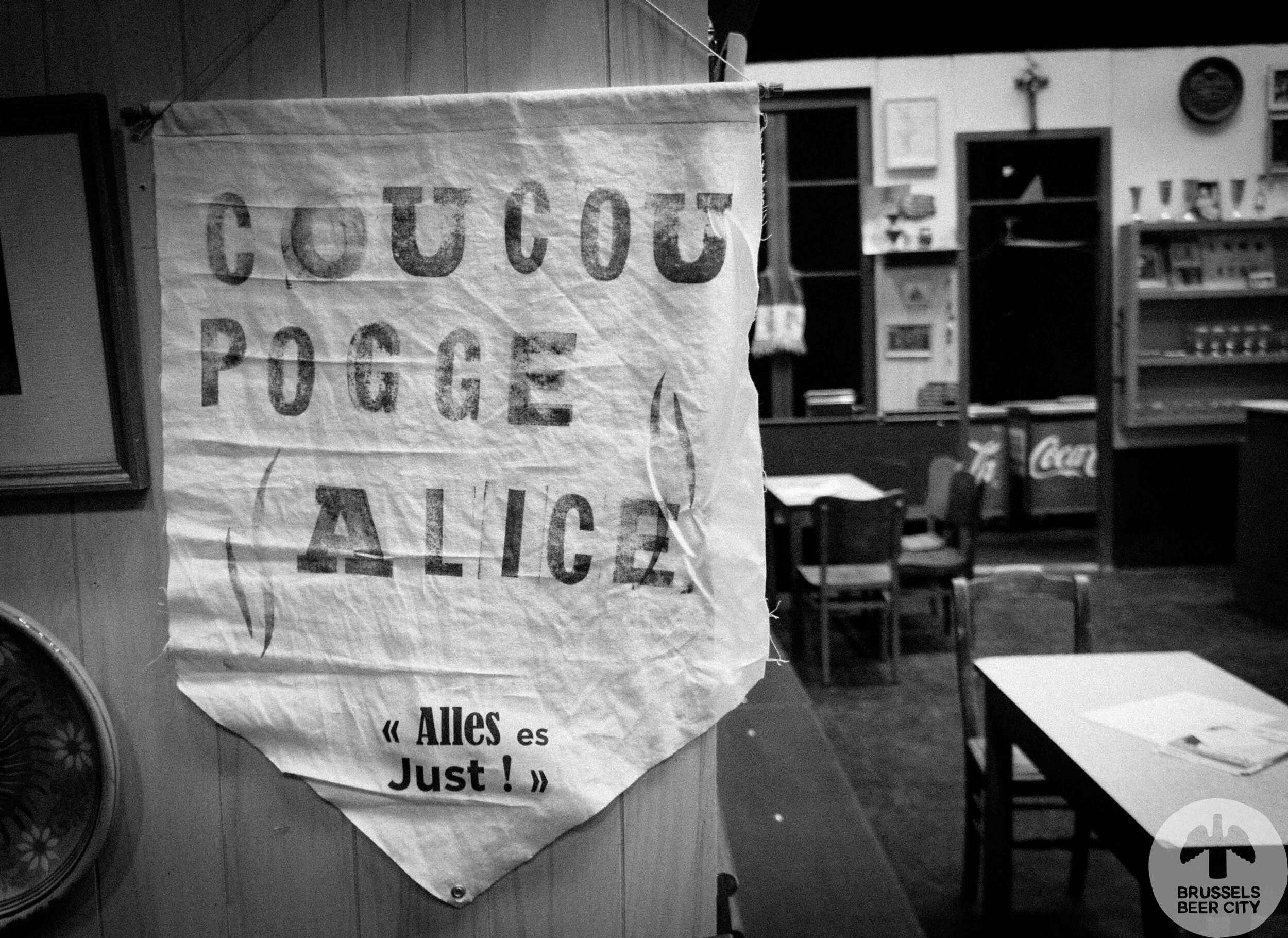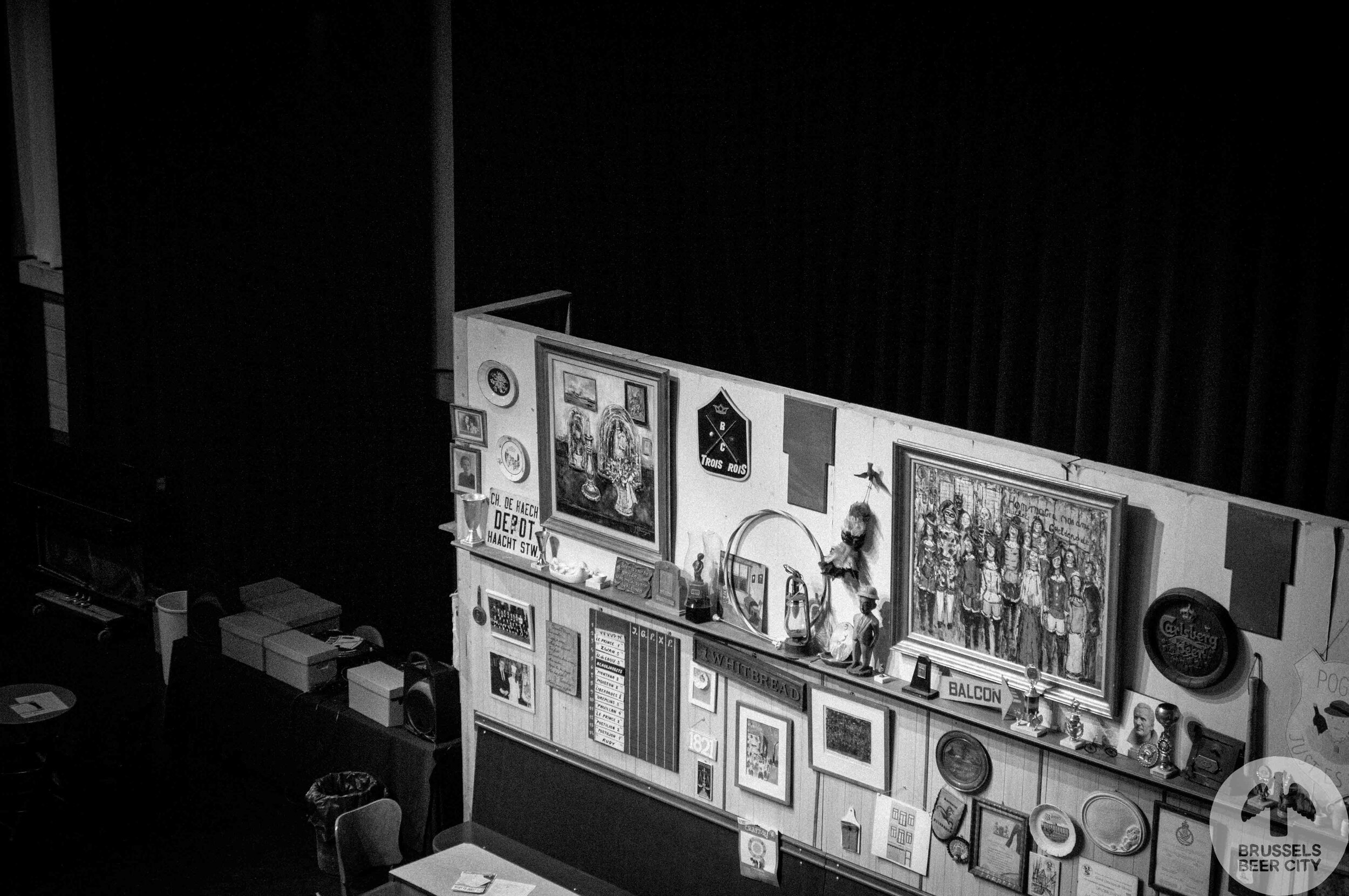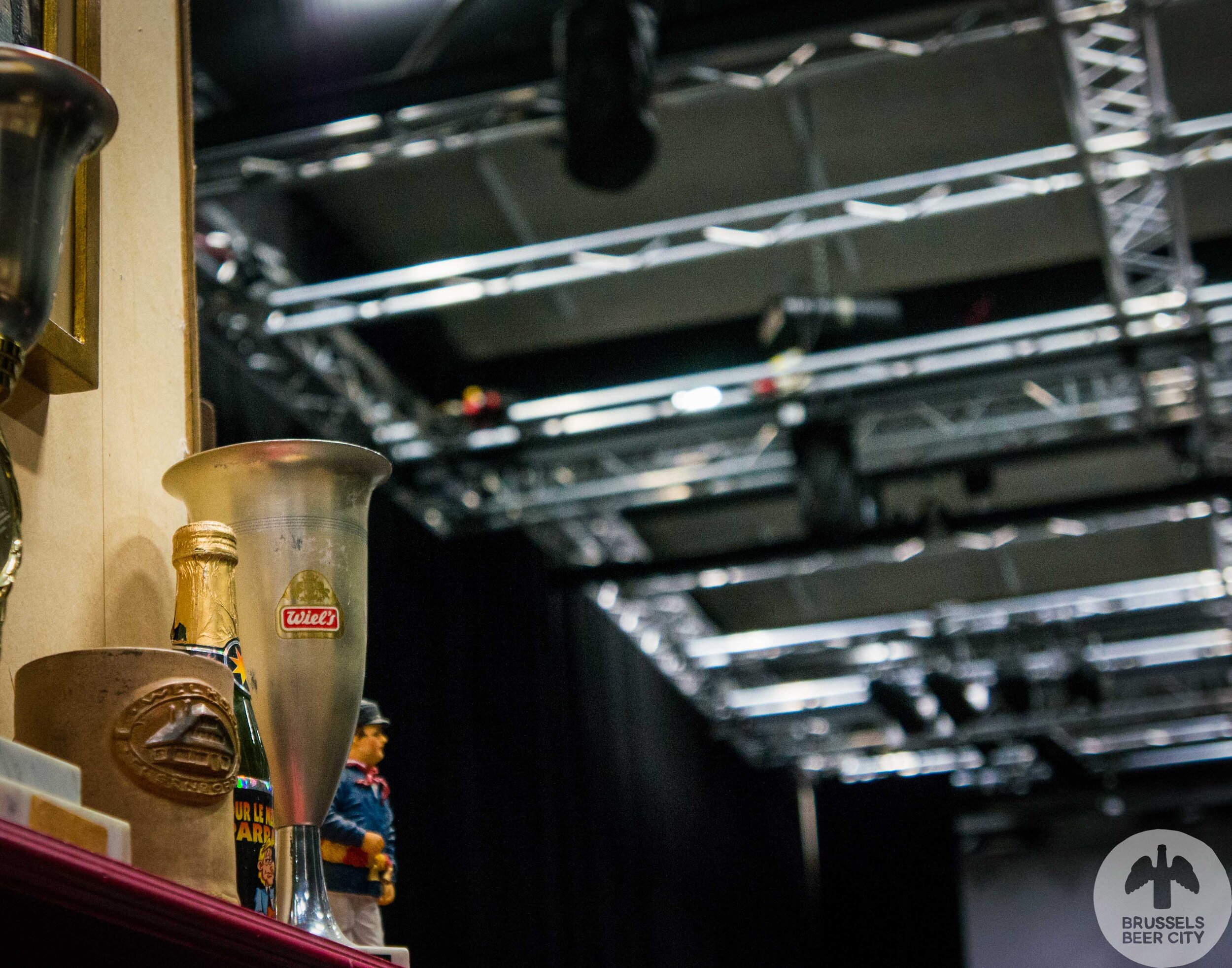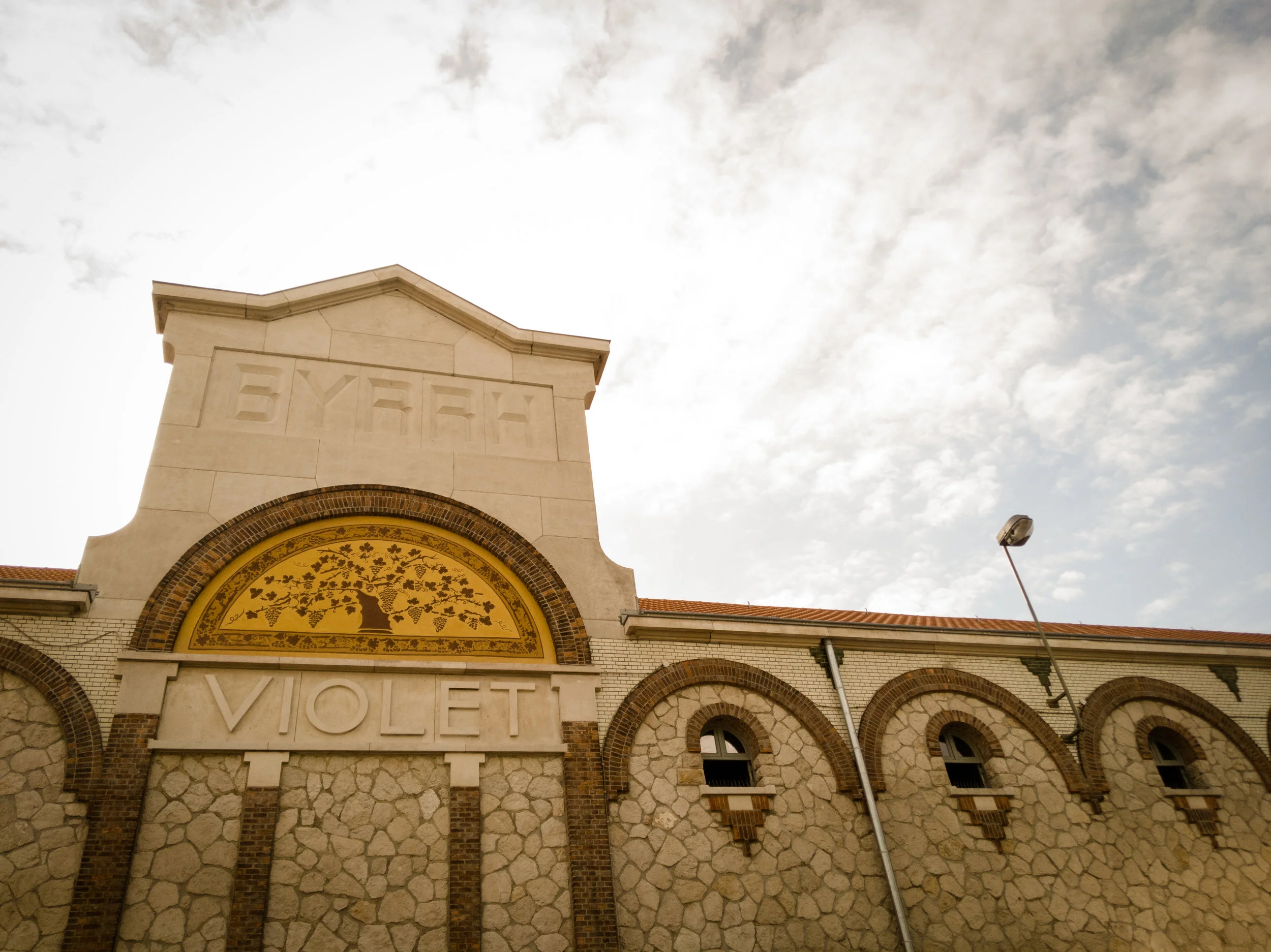Ceci n'est pas un café // Schaarbeek's Café Aux Trois Rois
Philippe Debroe never planned on becoming a pub landlord. He certainly never planned on owning a pub like the Café Aux Trois Rois.
Perched alongside a rickety wooden table several steps from the counter, the café’s interior should be familiar to anyone who has whiled away hours cradling a ribbeke glass of mass-market pils in a traditional Brussels pub. Hanging from tar-stained walls are a photograph of King Boudewijn and Paola, a faded and pock-marked dartboard, garish oils-on-canvas paintings likely pilfered from a local flea market, and wistful brewery memorabilia placed below shelves stacked with dented sporting trophies and defunct religious tokens. The room is small and the furniture is spaced out in front of racing green wooden banquettes worn smooth by the arses of several generations of drinkers. between the bar and the benches is a cabint housing the safe deposit boxes of the café’s 20th century customers. It’s a crowded tableau, displaying the sediment of memories accrued over deep time. A drinker might expect at any moment a balding man to shuffle out from behind the bar, navigating his cantilevered gut sheathed in a grubby marcelleke through the backroom door, Camel drooping from his cracked lips, ready to take his place at the counter for late night shift.
A glitch in the image
But Philippe Debroe is the café-baas at Aux Trois Rois and, wiry and nervously energetic, he does not fit this image. And nor is the view he presents in his café exactly all that appears. The canny drinker might have already spotted a glitch or two in the image. The rules for billiards are tacked up behind the bar, but there’s no billiard table. Shiny enamel adverts for Brasserie de la Senne hang alongside more age-worn examples from Campbell’s, Carlsberg Beer, and Whitbread - unexpected but not necessarily unusual. And what about those orange and green illustrations dotted around the bar’s three walls, tagged with the word Pogge, sitting awkwardly alongside the pastoral landscapes and photos of dear departed punters. The bar feels dusty, and yet there is grime on the windowsills. And then the more jarring dissonances. Those windows are absent of window panes, for one. That walls of the bar - the right colour but not the right texture, missing the build-up of tobacco smoke over decades - abruptly stop in mid-air. The fact that the bar has the unnerving feeling of a stage set, a feeling accentuated by harsh lighting where you might expect shadows. This Café Aux Trois feels precision-designed to evoke a lieu de mémoire - a memory place - but not inhabiting it fully.
“Once you’ve seen it you can never forget it. It’s a special bar”
And then the canny drinker will shake themselves out of this reverie and remember that this Café Aux Trois Rois feels more like a stage set than a café because that is what it is. That’s not strictly true though, because it’s also not not a café. It is more accurate to say that the Café Aux Trois Rois over which Philippe Debroe presides is part café, part art installation; the reconstruction from memory of a real Café Aux Trois Rois that was once the beating heart of a corner of the city’s Schaarbeek district. Philippe Debroe has instead conjured from his memory, his imagination, and his meticulous measurements this reproduction - rebuilt with the same decor and with the same spirit and relocated under the bright spotlights of a local Schaarbeek theatre. He built it to keep alive an important piece of Brussels’ working class folkloric tradition, a heritage tangible and intangible that is fast disappearing from the city. That, and the fact that, a decade previously, he was in desperate need for a place to celebrate his birthday.
“Once you’ve seen it you can never forget it”
In 2011 Philippe Debroe - originally from Turnhout in Flanders - was working as a translator and photographer out of his home in Schaarbeek where he’d lived for five years. He kept largely to himself, not involving himself in neighbourhood life and working on a photography assignment cataloguing the work of local heritage organisations. For several years he conspicuously failed to notice the awkward, tumbledown building several streets away plastered with faded enamel signs advertising “Spéciale Palm” and “Maes Pils”, the names Paula, Julo & Fils plastered above the front door. But he did eventually walk past it in the course of his photography work, and it made an immediate impression. “Once you’ve seen it you can never forget it,” he says. “It’s a special bar.”
Debroe’s work with local folklore groups had already sparked his interest in organising a folklore-centric project of his own, and at the same time was looking for a suitable venue to host his impending 40th birthday. The seemingly-abandoned Café Aux Trois Rois - estimated to be Schaarbeek’s oldest building (dating to 1722) and its oldest bar (with records dating from the mid-19th century) - appeared to be a neat solution for both these issues. But by time Debroe stumbled up on the café, it had been closed for a decade and a half - and looked it. “I started to peek in through the windows,” he says. “I noticed the bar, with all these objects and frames hanging [on the walls], decorating the bar…I saw little posters about carnival. I thought, this is a special place with history.” He rang the bell but no one answered. He tapped on the windows. Same result. Found the bar’s phone number but it rang and rang and rang. Eventually Debroe was put in touch with Jules Van Geele, Aux Trois Rois’ final owner. Van Geele - known to everyone as Julo - ran Aux Trois Rois with his wife from 1967 when they bought it until the mid-1990s. In this time, Julo embedded himself firmly in Schaarbeek’s civic and cultural life. Under his stewardship Aux Trois Rois was the meeting place for the neighbourhood’s pigeon fanciers, cycling clubs, football teams, war veterans associations, and more. One association above all others became central to Julo’s identity and with his vision for Aux Trois Rois - Les Amis de Pogge, the Friends of Pogge.
Brussels is a city dense with odd and obscure folkloric traditions, from lambic brewing to the monstrous géant puppets that parade through the city’s working class Marollen neighbourhood. Some of these traditions have a grounding in reality while others are the descendants of medieval flights of fancy. Pogge was the former. A resident of Schaarbeek and a habitué of Aux Trois Rois in the latter half of the 19th century, Pierre De Cruyer dit Pogge, was born in 1821. Kicked out of the military for excessive absenteeism brought on by excessive alcohol consumption, Pogge subsequently worked as a farm labourer.
“Alles Es Just”: Everything Is Correct
It was after the death of his wife in the 1880s that Pogge began to take on his title as folkloric mascot for his neighbourhood. From then on he could often be found in the company of his loyal Sancho Panza, a man called Jean Parici, propping up the bar at Aux Trois Rois and doling out opinion while knocking back glasses of faro and gueuze. In Pogge’s time, there was 1,600 or so estaminets in Brussels - a 19th century evolution of old roadside inns or herbergs that had improved their lighting, cleaned up the decor and sold beers not only from Brussels but from as far away as Hoegaarden to a more bourgeois clientele. Living across the road, Aux Trois Rois was Pogge’s logical choice of estaminets. And such was the appreciation for this melancholy figure that his friends established the Amis de Pogge. This group celebrated Pogge’s life and wisdom each autumn with a festival during which they paraded on their shoulders a miniature wooden reproduction of Pogge, decked out in his blue labourer overalls, around a nearby square (which had by then been renamed in his honour) in the manner of a saintly catholic procession.
“People in Belgium and especially in Brussels don’t like to preserve things, and especially people who have lived it from the inside”
On buying the café Julo resurrected the by-then moribund Amis de Pogge, evolving as President of the association into a latter-day Pogge and securing his own place in the neighbourhood’s traditions. Julo was crowned Prince of the Schaarbeek Carnival and was immortalised in wood and papier maché as a géant before his death. All of this was alien to Philippe Debroe before he discovered Aux Trois Rois. “I was never interested by folklore before,” Debroe says, but the more he learned, the more he wanted to know. “I was really interested by that figure [Pogge], [and] I asked lots of questions.” Julo invited him into the café, and together they peeled back the layers of history archived in a jumble of family and business photo albums charting Julo's time behind the bar. “There we discovered the richness of the place,” Debroe says. It was a soul in hibernation; in the years after the café’s closure in the 1990s, Julo kept the spirit of Aux Trois Rois alive by opening it a couple of times a year for celebrations, and was happy to open it one more time for Debroe to host his birthday party there.
In parallel, Debroe began putting together his own folklore project based on his interactions with Julo, and shopped it around to several of Brussels’ myriad government administrations in search of funding. The Alles es Just festival in 2012 was the result, named in honour of Pogge’s stock answer to anyone who solicited his opinion - “Alles es just” (everything is correct) - with an exhibition based on the café’s photo archive, and a programme of events and accompanying pamphlet centred on the story of Pogge. Debroe’s transformation from disinterested passerby to fellow traveller in the battle for Brussels’ fast-disappearing intangible cultural heritage was underway.
A Special Man
Alles es Just ran from 2012 to 2014 out of Aux Trois Rois, but by 2015 Julo’s health had declined to the point where his family and Debroe agreed it was better to relocate it. A year later, in the early morning of New Year’s Eve 2017, Julo passed away. “[He was] a special man,” he says. Debroe’s thoughts soon turned to the uncertain fate of Aux Trois Rois, and to Julo’s commitment to keeping the spirit of Pogge alive. “I thought, if Julot dies, it will die also,” he says. “People in Belgium and especially in Brussels don’t like to preserve things, and especially people who have lived it from the inside.”
Julo’s family had grown tired of the bar, and Debroe felt they were, understandably, ready to let it go. The Amis de Pogge had little inclination to work with him; Debroe says they were “very hostile” to what they perceived as a Flemish interloper backed by Flemish money interfering in their tradition. And at the same time elsewhere in Brussels, a wave of closures and renovations were scouring the city of its scruffier cafés, lieux des mémoires just like Aux Trois Rois gradually being supplanted by more contemporary establishments targeted at a newer, more sanitised, public. The café had limped on for several decades longer than expected, but it looked as if its time was finally drawing near. If Debroe couldn’t save it from disappearing, what he could do was rescue from oblivion was the soul of the place - the trinkets and trophies, the pictures and paintings, the accumulated detritus that gave it character and charted the history of the place and its customers through a century’s drinking and carousing. Julo before his death had already recognised the value of this otherwise worthless collection of kitsch, when placed in its proper context. “Julot considered this place to be a little museum,” Debroe says. “When the pub was open, there was nothing on the walls. But after closure [in 1995] he decided to decorate it, and open once a year for Carnival. For the rest of the time the place was sleeping.”
“I think it is a city with a lot of heritage, and many people don’t know it or are not interested in it”
Julo’s family were less interested in Debroe’s mission, and as they unwound their connection to the café, they began disposing of these artefacts. “They were throwing things away, putting it in bags and putting them on the street,” Debroe says. “I thought I had to look in these, [and I found] archives from Les Amis de Pogge…very interesting material. I took it to my house and put it aside [and] I said, ‘Don’t throw it away because I and other people are interested.’” Debroe began inventorising, and bought what remained from Julo’s family. A close friend of Julo’s who still lived at the café and tipped him off whenever things starting disappearing, and facilitated some last-minute surveying before the café was sold. “Two days before the day of demolition, I was able to go with [Julo’s friend] Pierre to measure everything, the benches, the bar position, everything.” With these measurements and his collection, Debroe launched the next step of his plan to keep Aux Trois Rois alive: the construction of a life-size reproduction of Café Aux Trois Rois built of wood and accurate down to the colour of the green wood panelling and the placement of the burgundy wooden countertop, and populated with the chairs, tables, and chintz Debroe had rescued from the rubbish dump. All it was lacking was the grimy checkerboard tiling underfoot, and of course Julot propped up behind the bar.
Rescue and Reconstruction
Constructed in the late summer of 2016, by October that year the pop-up reconstruction of Aux Trois Rois was ready to be installed by Debroe in the theatre space of a nearby cultural centre. It is an uncomplicated and unremarkable construction, a wooden frame several centimetres thick with three sides, held up externally by a series of buttresses. And when confronted with it for the first time under the glare of the stage-lights, Debroe was uncertain whether his collection could imbue it with Julo’s and Pogge’s spirit. “Before everything hung on it I thought, ‘What is this, it looks different!’,” he remembers. But he began unpacking his myriad boxes and hanging their contents on the walls with the precision and feel he applied to his photography work, a familiar image cohered before him. “Each object is something special, because most of the objects are of no value,” he says, leaning back and pointing towards the photo of Belgium’s former King Boudewijn. “It’s a stupid object. Or the little landscape [painting below it]. It’s something you don’t even know where it comes from.”
But together they transformed this ersatz stage set into something more tangibly real. The collection is constantly evolving, and what doesn’t fit on the walls is stored in crumpled cardboard boxes piled up behind the walls. Debroe has added items from his own collection, including those garish paintings of scenes from life in the Marollen from local painter, puppet-maker and honorary ‘Prince of the Marollen’ Jef Bourgeois. Other additions have come from collaborations with local artists. Those odd little brightly coloured green and orange illustrations were part of an installation by Brussels-based US artist, folklore enthusiast and puppeteer McCloud Zicmuse charting the important numbers, events and locations of Pogge’s life.
A genius for folklore and heritage
Collaborations like these are an essential part of what Debroe wants to achieve with his version of Aux Trois Rois. “This is folklore, but it’s more than that. It’s a festival that brings people together,” he says. “What’s important to me is to work with heritage and to renew it. To give all people the possibility to work with…history [and] everything which is related to Schaarbeek.” His memory place is a conscious rejection of a Brussels which in the past has shown scant regard for its heritage - architectural, cultural, alcoholic - and which today is loosening its relationship with its local tradition and its language. “I think it is a city with a lot of heritage, and many people don’t know it or are not interested in it,” Debroe says. “That’s what I like to work with subjects which other people are not interested…I prefer to work locally, and with artists and illustrators which have a genius to give another dimension to that folklore and history.” It’s one of the reasons why he works with Brasserie de la Senne’s in-house illustrator Jean Goovaerts (also a member of his extended family) on the festival’s visual identity - someone who has lived through a topsy turvy half century in Brussels and lives and whose illustrations for the brewery and the festival are a vibrant retelling of the city’s folk stories.
Eight years after his first accidental encounter with an abandoned roadside café morphed into a festival of folklore, folk memory, and an artfully reconstructed facsimile, Debroe’s passion for Aux Trois Rois remains undimmed. 2020’s edition had an unfamiliar feel, taking advantage of the brief window between the Spring and Autumn Covid-induced lockdowns for a pared-back Alles Es Just festival featuring film screenings, exhibitions, historical walking tours around Schaarbeek - and of course (socially-distanced) evenings at Aux Trois Rois. “To see how people coming from other regions…this bar gives possibilities everywhere. [It remains] une source d’inspiration totale.”
And Debroe was there to welcome them from behind the bar with a beer and a story about Pogge, standing where Julo might have stood with a limp cigarette dangling from his beer-dampened lips, the accidental café-baas in his imagined café.




































